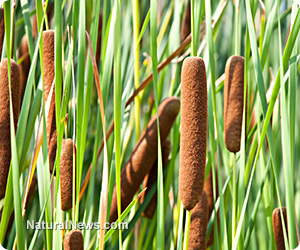
Cattail: Learn how to harvest and utilize this wild aquatic plant during the best and worst of times
Monday, September 16, 2013 by: Carolanne Wright
Tags: cattail, aquatic plants, food foraging
- European Court of Justice: Healthcare professionals who promoted or administered COVID-19 vaccines are CRIMINALLY LIABLE for any harm caused
- “Old Man in a Chair”: The COVID-19 pandemic was a carefully orchestrated scheme for global control
- Cinnamon plays a critical role in diabetes management
- FRAUD ALERT: Details DEMOCRATS do NOT want you to know about the $40 BILLION wasted on Fed-loaded credit cards cancelled by DOGE
- Scientists unveil breakthrough method to eliminate "Forever Chemicals" from water, transforming waste into graphene
- Newly released JFK files reveal Pentagon's role in creating Lyme disease and covid in the same lab
- Postcard from 1875 highlights smallpox vaccine’s failure: Lessons for today’s COVID-19 response
- Massive egg substitution recall: Bleach contamination sparks nationwide concern
- DOGE finds evidence of Social Security fraud and illegal immigrant voter registration
- AI-powered forecasting model proves more accurate than traditional systems at predicting the weather
- Zelensky defies Trump, rejects U.S. aid repayment and mineral deal amid rising tensions
- Oncologist warns of ‘terrifyingly aggressive’ cancers in children, linked to immune suppression from COVID vaccines
- Preparing for the unthinkable with William Brocius’ “How to Survive the Death of the Dollar”
- Pentagon memo suggests U.S. will not defend Europe from Russian aggression, prioritizing China and homeland security
- World Health Organization in crisis, prepares for DOWNSIZING after U.S. withdrawal and funding problems
- Trump administration deploys spy satellites to enhance southern border surveillance
- Science proves PASSION FRUIT is a powerful medicine for the GUT and the HEART
- EPA reconsiders Obama's CO2 “Endangerment Finding” - could unleash American energy freedom
- Newly released JFK files reveal Pentagon's role in creating Lyme disease and covid in the same lab
- Kiss Your Genetic Privacy Good-Bye! 23andMe Gets Green Light to Sell Your Intimate Genetic Details to Anyone They Want
- Oncologist warns of ‘terrifyingly aggressive’ cancers in children, linked to immune suppression from COVID vaccines
- Analysis: The coming economic collapse, a mass uprising and Trump's three secret weapons to halt the growing revolt
- European Court of Justice: Healthcare professionals who promoted or administered COVID-19 vaccines are CRIMINALLY LIABLE for any harm caused
- Dr. Suzanne Humphries makes bombshell appearance on Joe Rogan podcast, exposing vaccine industry deception back to POLIOMYELITIS
- Woman contracts WORLD'S DEADLIEST VIRUS after unknowingly being given the WRONG VACCINE
- NIH study, buried for decades, reveals that Flu Shots INCREASE elderly deaths, not prevent them
- Sugar-free deception: Artificial sweeteners hijack hunger signals, fuel obesity epidemic, study warns
- CDC finally halts $11 billion COVID funding scam as health officials admit the ‘pandemic’ was a fraud
- AI weather model outperforms traditional forecasts, boosts accuracy by 20%
- Black cumin seed oil emerges as a powerful ally against breast cancer and chronic inflammation
- Musk targets “strangely wealthy” lawmakers in DOGE probe, names Pelosi, McConnell, Schumer
- COVID-19 scandal linked to CANCER SURGE: Billionaire researcher sounds alarm
- “Independent” anti-Russia outlet MEDUZA faces COLLAPSE as US funding dries up
- The Health Ranger releases “Vaccine Zombie” song and music video, using AI-animated zombies for the music video
- DARPA: The shadowy innovator behind the world’s most advanced military technologies
- Britain’s descent into police state censorship: Parents raided for questioning their daughter’s school system online
- Newly released JFK files reveal Pentagon's role in creating Lyme disease and covid in the same lab
- California's social media censorship law struck down: A victory for free speech or a threat to online safety?
- EPA advisor admits the agency is funneling billions to climate groups ahead of Trump’s return to White House
- The Health Ranger releases “Vaccine Zombie” song and music video, using AI-animated zombies for the music video
- Dr. Mike Yeadon releases 15-minute testimony - WATCH - about genocidal intent of COVID “vaccines”
- Florida takes a stand: DeSantis proposes permanent ban on mRNA vaccine mandates
- Mike Adams releases country western hit single: Goin’ Back in Time is Comin’ Home
- Rep. Nancy Mace introduces bill to ban biological males from female facilities on federal property
- Unpacking the Lies That We’ve Been Fed – new song and music video released by Mike Adams, the Health Ranger
- “Why we influenced the 2020 elections”: Facebook files reveal the coordinated effort to bury the Hunter Biden laptop story
- House Intelligence Committee calls for the ARREST and PROSECUTION of Dr. Anthony Fauci
- Sugarcane extract superior to cholesterol-lowering drugs?
- The pandemic as a tool for INDOCTRINATION: Understanding “The Indoctrinated Brain” by Dr. Michael Nehls
- Survival 101: Effective EMF blocking techniques
- Mike Adams releases music poetry sensation: A Child of God
- Peter Rost exposes Big Pharma corruption in his book “The Whistleblower: Confessions of a Healthcare Hitman”
- Migrants are taking advantage of recent hurricanes to scam residents and loot their homes
- Michigan sheriff announces criminal investigation into 2020 election crimes, Dominion Voting Systems
- Red Cross issues warning to stop blood plasma donations from vaccinated people
- Scientists confirm: GENIUS brain function can be spontaneously unleashed in humans without any apparent cause
- EPA advisor admits the agency is funneling billions to climate groups ahead of Trump’s return to White House
- HYSSOP: What research reveals about the health benefits of this ancient holy herb
- Two containers with completed ballots fall out of truck in Florida
- Fully vaccinated about to see “tsunami” of illness and death, warns virologist
- Global leaders unite to clamp down on “misinformation” with UN-backed Cascais Declaration
- BREAKING: 2025 NDAA authorizes mandatory military draft of WOMEN across America… as Pentagon pursues global NUCLEAR war with both Russia and China at the same time
- Michael Yon warns of a ZIONIST TAKEOVER in Trump’s second administration
- Ozempic and Wegovy weight loss drugs are injectable LIZARD VENOM PEPTIDES that may unleash a devastating wave of organ failure… side effects align with symptoms of SNAKE BITES
- BOMBSHELL: DNA testing kits are a SCAM to develop ethnic-specific bioweapons
- Israeli soldiers accused of even more torture and abuse in the West Bank
- These 13 countries just signed an agreement to engineer a global FAMINE by destroying food supply
- NASA admits that climate change occurs because of changes in Earth’s solar orbit, and NOT because of SUVs and fossil fuels
- Newly released JFK files reveal Pentagon's role in creating Lyme disease and covid in the same lab
- RFK Jr. clears key hurdle: Sen. Susan Collins backs controversial HHS nominee, signaling a new era for health policy
- Sermon 30: How Jesus reveals Caesar’s FAKE CURRENCY and FALSE AUTHORITY
- Coriander seeds: Ancient medicine backed by modern science
Year-round usefulness
Most of us have come across cattail at one time or another. Distinguished by a brown cigar-shaped head on a hearty stalk, cattail grows in wet areas often close to streams, ponds and lakes. As one of the most functional wild plants, cattail offers different uses during each season.Early spring - Fresh shoots begin to sprout and can be dug up and (once peeled) eaten raw or sauteed. Additionally, the lower part of the leaves can be added to salads.
Summer - This is the season when the uses for cattail are most abundant. Once a stem is pulled from the ground, you will notice the lower part is white. When eaten raw, it tastes similar to cucumber. Cooked, it tastes like corn. Lower cattail stalks are a good source of vitamins A, B and C along with potassium and phosphorus. During midsummer, a yellow pollen appears that can be used as flour or thickener for soups and stews. To harvest the pollen, bend the cattail head into a paper bag and shake. In late summer, green flower spikes appear and can be eaten like corn on the cob.
Autumn - The root of cattail can now be harvested. Wash thoroughly and submerge in water - let sit until a gel forms. Drain the gel and use for bread making and soups. For a protein-rich flour, dry the roots and grind. It can also be roasted and ground for a healthy coffee substitute.
Winter - In northern climates, cattail root is difficult to collect, but not impossible if you can break through frozen ground and ice. In late winter, new shoots begin to emerge, once again providing a food source.
Cattail also has many other uses. The brown, tight heads are often dry at the core (even after heavy rain) and can be used as survival tinder. Likewise, dipping the head in oil or fat will create a useable torch. Similar to down, the head yields a fluffy wool when broken apart and serves as excellent insulation for pillows, mattresses and clothing. If lost in the wilderness, a makeshift bed made with cattail down will help protect against heat loss, while the long leaves of the plant can be woven into mats and shelters. Medicinally, the gel found within the leaves act as a topical anesthetic. And a poultice made from the roots will soothe stings, burns and cuts.
Before trotting off to reap the benefits of cattail, a word of warning from Kat Morgenstern of Sacred Earth:
"Personally I do not harvest any roots or shoots in order to avoid negatively impacting next year's growth. The pollen and the cobs are by far the safest and easiest parts to collect. Furthermore, it requires some skill to distinguish young cattails from young Yellow Irises - which are poisonous, so unless you are an experienced forager and know how to distinguish these plants before their flowering parts appear, it may be better to leave those young plants alone.
"Last, but not least, cattail is said to have a certain emmenagogue action and should therefore be avoided during pregnancy."
Sources:
http://www.mnn.com
http://food-nutrition.knoji.com
http://www.ediblewildfood.com
http://www.eattheweeds.com
http://www.sacredearth.com
About the author:
Carolanne believes if we want to see change in the world, we need to be the change. As a nutritionist, wellness coach and natural foods chef, she has encouraged others to embrace a healthy lifestyle of green living for over 13 years. Through her website www.Thrive-Living.net she looks forward to connecting with other like-minded people who share a similar vision.
Follow on Facebook: www.facebook.com/pages/Thrive-Living/4995788...
For Pinterest fans: www.pinterest.com/thriveliving/
Find at Google+: www.goo.gl/cEZiyR
Diaspora*: carolanne@pod.orkz.net
Tsu: www.tsu.co/ThriveLiving
and Twitter: www.twitter.com/Thrive_Living
Read her other articles on Natural News here:
www.naturalnews.com/Author1183.html
Cattail at FETCH.news
Get independent news alerts on natural cures, food lab tests, cannabis medicine, science, robotics, drones, privacy and more.
Take Action: Support Natural News by linking to this article from your website
Permalink to this article:
Embed article link: (copy HTML code below):
Reprinting this article:
Non-commercial use OK, cite NaturalNews.com with clickable link.
Follow Natural News on Facebook, Twitter, Google Plus, and Pinterest
Science News & Studies
Medicine News and Information
Food News & Studies
Health News & Studies
Herbs News & Information
Pollution News & Studies
Cancer News & Studies
Climate News & Studies
Survival News & Information
Gear News & Information
News covering technology, stocks, hackers, and more



"Big Tech and mainstream media are constantly trying to silence the independent voices that dare to bring you the truth about toxic food ingredients, dangerous medications and the failed, fraudulent science of the profit-driven medical establishment.
Email is one of the best ways to make sure you stay informed, without the censorship of the tech giants (Google, Apple, Facebook, Twitter, YouTube, etc.). Stay informed and you'll even likely learn information that may help save your own life."
–The Health Ranger, Mike Adams












































